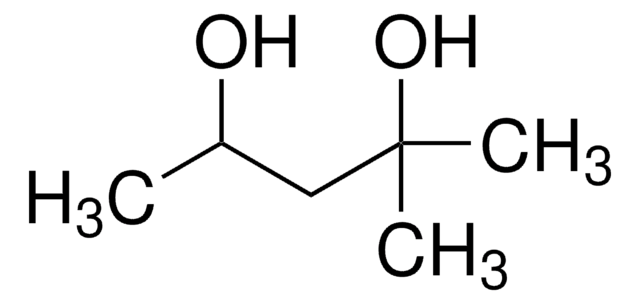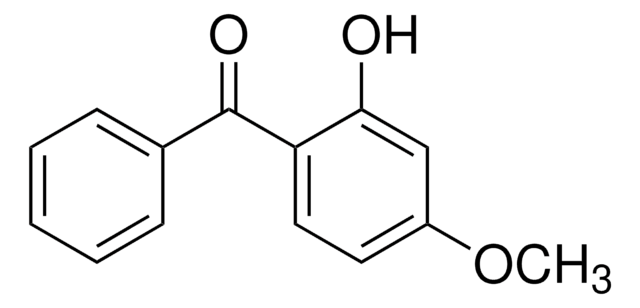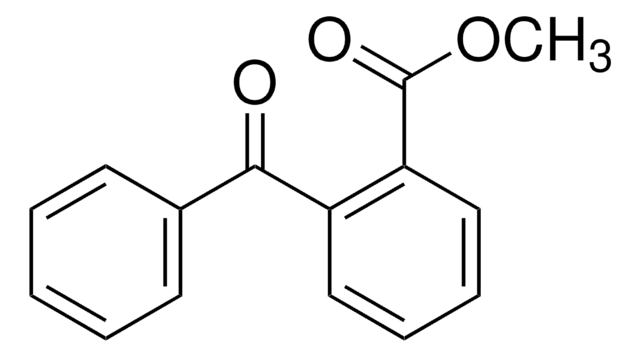437395
4-(二甲氨基)苯甲酸-2-乙基己酯
98%
别名:
2-乙基己基 4-(二甲基氨基)苯甲酸酯, 2-乙基己基 p -(二甲基氨基)苯甲酸酯, 2-乙基己基4-(N ,N -二甲基氨基)苯甲酸酯, 2-乙基己基N ,N -二甲基-p -氨基苯甲酸酯, 4-(二甲基氨基)苯甲酸2-乙基己基酯, 十六烷基二甲基乙基溴化铵(EHDAB), 辛基二甲基对氨基苯甲酸
登录查看公司和协议定价
所有图片(1)
About This Item
线性分子式:
(CH3)2NC6H4CO2CH2CH(C2H5)(CH2)3CH3
CAS号:
分子量:
277.40
EC號碼:
MDL號碼:
分類程式碼代碼:
12162002
PubChem物質ID:
NACRES:
NA.23
推荐产品
化驗
98%
形狀
liquid
折射率
n20/D 1.542 (lit.)
bp
325 °C (lit.)
密度
0.995 g/mL at 25 °C (lit.)
SMILES 字串
CCCCC(CC)COC(=O)c1ccc(cc1)N(C)C
InChI
1S/C17H27NO2/c1-5-7-8-14(6-2)13-20-17(19)15-9-11-16(12-10-15)18(3)4/h9-12,14H,5-8,13H2,1-4H3
InChI 密鑰
WYWZRNAHINYAEF-UHFFFAOYSA-N
正在寻找类似产品? 访问 产品对比指南
一般說明
2-乙基己基4-(二甲氨基)苯甲酸盐是一种有机紫外线过滤剂,广泛用于制备防晒霜和丙烯酸超薄膜。
應用
- 2-乙基己基4-(二甲氨基)苯甲酸(OD-PABA)在地表水相关条件下的光化学转化研究本研究旨在调查2-乙基己基4-(二甲氨基)苯甲酸酯在水生环境中的光化学特性和转化产物,突出其对环境的影响(Calza et al., 2016)。
- 光防护或光损伤:2-乙基己基4-二甲氨基苯甲酸酯防晒剂非辐射动力学的直接观察:该论文提供了对2-乙基己基4-二甲氨基苯甲酸酯非辐射动力学的见解,评估了其作为防晒剂的有效性和光损伤的可能性(Ma et al., 2018)。
- 2-乙基己基-4-二甲氨基苯甲酸酯在水生动物体内的生物蓄积和生物放大作用:本研究考察了2-乙基己基-4-二甲氨基苯甲酸酯在水生生物中的生物积累和生物放大潜力,为其环境持久性和影响提供了有价值的数据(Lu et al., 2018)。
訊號詞
Danger
危險聲明
危險分類
Repr. 1B
儲存類別代碼
6.1C - Combustible acute toxic Cat.3 / toxic compounds or compounds which causing chronic effects
水污染物質分類(WGK)
WGK 2
閃點(°F)
374.0 °F - closed cup
閃點(°C)
190 °C - closed cup
個人防護裝備
Eyeshields, Gloves, type ABEK (EN14387) respirator filter
其他客户在看
Ana Gil-Vergara et al.
Analytical and bioanalytical chemistry, 389(2), 605-617 (2007-07-25)
Liquid chromatography-tandem mass spectrometry (LC-MS/MS) and gas chromatography-mass spectrometry (GC-MS) have been compared for the analysis of 2-isopropyl thioxanthone (ITX) and 2-ethylhexyl-4-dimethylaminobenzoate (EHDAB). Pressurized liquid extraction (PLE) was applied for the extraction of ITX and EHDAB from milk and milk-based
P J McHugh et al.
Photochemistry and photobiology, 66(2), 276-281 (1997-08-01)
We describe an in vitro approach to assessing the potential genotoxicity of illuminated sunscreens. The photomutagenic sunscreen Padimate-O attacks DNA on illumination with simulated sunlight, producing strand breaks and lesions that are labile to N,N'-dimethylethylenediamine but few, if any, cyclobutane
S H Dromgoole et al.
Journal of the American Academy of Dermatology, 22(6 Pt 1), 1068-1078 (1990-06-01)
Reports in the literature of sensitization associated with many commonly used sunscreening agents including p-aminobenzoic acid (PABA), PABA derivatives, anthranilates, salicylates, cinnamates, benzophenones, and dibenzoylmethane derivatives are reviewed. Several of these case reports involved subjects with various photodermatoses, implicating enhanced
R Bestak et al.
The Journal of investigative dermatology, 105(3), 345-351 (1995-09-01)
This study compares the ability of two ultraviolet (UV) B-absorbing sunscreens, 2-ethylhexyl p-methoxycinnamate (2-EHMC) and 2-ethylhexyl p-aminobenzoate (Padimate O), and two physical sunscreens, microfine titanium dioxide (MTD) and zinc oxide, to protect the skin immune system from chronic (4 weeks)
Joseph A Nicolazzo et al.
Journal of pharmaceutical sciences, 94(4), 873-882 (2005-03-01)
In previous experiments, it was suggested that the reduction in estradiol (E2) buccal permeability after pretreatment with some skin penetration enhancers was attributed to enhanced membrane storage. To verify this, further in vitro permeability experiments were performed and the kinetics
我们的科学家团队拥有各种研究领域经验,包括生命科学、材料科学、化学合成、色谱、分析及许多其他领域.
联系技术服务部门












![2,2′-亚甲基双[6-(2H-苯并三唑2基)-4-(1,1,3,3-四甲基丁基)苯酚] analytical standard](/deepweb/assets/sigmaaldrich/product/structures/236/824/ce89085c-b9e1-4ea0-8157-44b6f9466ed6/640/ce89085c-b9e1-4ea0-8157-44b6f9466ed6.png)
